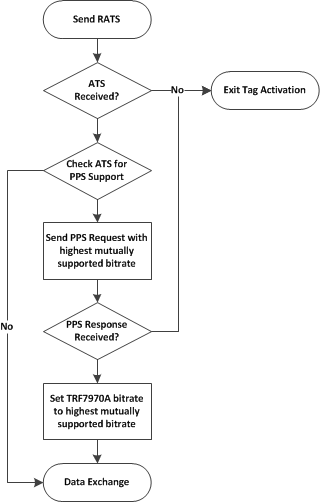SLOA227B October 2015 – March 2019 TRF7964A , TRF7964A , TRF7970A , TRF7970A
-
NFC/HF RFID reader/writer using the TRF7970A
- Trademarks
- 1 Terms, Definitions, and Symbols
- 2 Introduction
- 3 Initial RF Collision
- 4 TRF7970A Register Settings
- 5 Reader/Writer Mode
- 6 Hardware Description
- 7 Reader/Writer Firmware Example
- 8 Quick Start Guide
- 9 Operational Overview
- 10 Reader/Writer Interoperability Results
- 11 Conclusion
- 12 References
- Revision History
5.1.1.1 Additional Tag Activation Commands for Type 4A Tags
Tags that communicate with NFC-A technology and are ISO14443-4 compliant are considered Type 4A tags and must be sent an additional command, RATS, to finish the activation process and allow the exchange of data. There is also an optional command, PPS Request, that can be sent prior to entering data exchange. Because the example firmware provided sends both of these commands (see Figure 10), this section describes how both of them work.
 Figure 10. Tag Activation Process for Type 4A Tags
Figure 10. Tag Activation Process for Type 4A Tags - Request Answer To Select (RATS)
- Protocol and Parameter Selection Request (PPS Request)
The RATS command is used to select a Type 4A tag that has indicated support for ISO14443-4. All Type 4A tags must respond to the RATS command by sending back an Answer to Select (ATS) response. The ATS response can optionally include information about supported bit rates, timing requirements, and optional fields for over the air commands. For further detail on the format of the ATS response, refer to the ISO14443-4 specification.
The PPS Request command is an optional command that can be issued by the reader to increase the communication bit rate with a Type 4A tag. The ATS response contains the information about the supported bit rates: 106 kbps, 212 kbps, 424 kbps, and 848 kbps. With this information, the firmware determines the highest mutually supported bit rate by comparing the ATS response to the enabled reader/writer bit-rate settings, and send that bit rate to the tag in the PPS Request to ensure that the tag will operate at that data rate.
Upon receiving a PPS Response, the firmware will set the ISO Control register (0x01) with the correct settings to transmit data at the previously determined bit rate. At this point both the reader/writer and the Type 4A tag are ready to begin exchanging data.